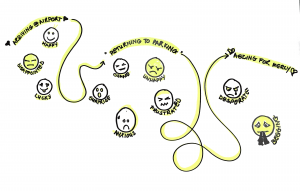A closer look at complex emotional processing in customer journey design
The 27 emotions: admiration, adoration, aesthetic appreciation, amusement, anger, anxiety, awe, awkwardness, boredom, calmness, confusion, craving, disgust, empathic pain, entrancement, excitement, fear, horror, interest, joy, nostalgia, relief, romance, sadness, satisfaction, sexual desire, surprise *(University of California, Berkeley)
The emotional experience of customers while interacting with a brand, lies at the epicentre of today’s customer experience economy. Understanding what customers feel is essential to experience design and to ensure prosperity through customer loyalty.
On one level, we want to design experiences that customers will remember and enthusiastically share with others, endorsing and promoting our brand. But on another level, we also want to understand what customers go through while they interact with us. This enables us to constantly improve our service delivery to delight our customers.
The challenge is that human emotions are complex. People find it difficult to identify and define their own and others’ emotions. This then is often the root of misunderstandings and disappointments in human connection. We found exactly that, when interviewing thousands of customers about their brand experiences. Consumers find it difficult to define and articulate what they feel, and we too often hear that the experience was “fine” – due to inadequate emotional vocabulary.
In his article ‘The Accidental Customer Experience’, customer experience guru Ian Golding writes about the 206 flights he undertook in a year. In summary he says, you don’t really notice anything, until you notice something. The extent to which we are able to recall such an experience, depends to a large extent on what was subconsciously triggered and the impact it had on us.
The average person is not consciously aware of every fleeting thought or emotion that races through the subconscious. It is these deep triggers, that lurks in the shadows of our subconscious, that matter: shame, fear or guilt. Through these “lenses” we view our experiences and shape our responses. In a study conducted at The University of California, participants were exposed to various short video clips to evoke emotions. Thousands of emotions were identified but all were categorised into one of 27 distinct emotions (anger was not one!).
In many cases, consumers (and clients) are not that introspective, empathetic or socially aware, making it challenging to gratify them. It is difficult to relate to emotions that we cannot describe, and even trickier to evoke emotions, when we are not able to define it.
Building empathy
Empathy is the ability to place oneself in another’s shoes and see the world through their eyes. This requires you to work on the emotional playing field, something most people shy away from. People experience a fair amount of discomfort in acknowledging and articulating their own emotion, and it’s even more challenging to identify it in others. It is easy to think of how angry or disappointed you felt in a particular situation, but seldom do we focus on the range of emotions we experience in our dealings with people, and those leading to the interaction. In business contexts, people are also often discouraged by a collective understanding that emotions are “not okay”.
Defining a Brand’s Experience Essence
To design your customers’ experience with your brand, first ask: “What is your brand’s experience essence?”
In other words, what should customers feel when interacting with you? We encourage companies to clearly define this, and then infuse this experience essence on every level in the business. Every interaction should underscore the brand’s “DNA”. All channels should speak the same language, with the intention to ensure customers have a consistent experience. The Experience Essence is a simple-to-understand description of what you want your customers to feel. Many companies neglect to do this, making it very difficult for employees to understand what they need to do, to deliver a service that will delight customers. Here are examples of what could be included in an experience essence: “to make our customers smart”, “to experience amazing”, “to make customers feel loved”.
To illustrate complexity of emotions throughout a journey, the following step-by-step account of a customer’s thought process and emotions (internal narrative) will illuminate how experience is shaped. The keys to understanding the emotional journey lie in deep-rooted needs, triggers and the stories we tell ourselves.
What story do you wish your customers to tell themselves when they interact with you?
Case study of a brand interaction with ASCA parking at OT International Airport
Summary of the incident
- Unaware, this customer parks in a drop-off area after diverting from the closed long-term parking entrance into the 1st entrance to the parking building.
- On her return after a 3-day trip, she is surprised to find a R3,000 parking ticket.
- Convinced it’s a system error, she consults the security who takes her to the entrance to point out the sign (which she had not seen on entry).
- They then send her off to the parking office to see what can be done. (It’s a Sunday evening). She finds that no one is authorised to consider the situation
- She duly pays to avoid further fees and to be able to return home.
- She directs a plea to ACSA, who investigated the case and ultimately offered a R1,500 reduction (settled a month later)


Internal narrative of this emotional journey
As I arrive at the airport for my flight out, my heart sinks when I see the closed sign at the long-term parking. After (berating) myself for not taking an Uber as originally planned and not leaving earlier, I am delighted to see the first parking entrance, and find a spot – “my angels are with me today and I am on time” (happy).
Two days later…
“Feeling great – everything on my trip ran smoothly and on time (happy). All too often, trips were delayed – I am lucky (relief and joy).
As I head off to pay for my parking, a security guard approaches me, and I start to feel nervous. At the ticket station I had to look twice at the charge, R3,000! (shock). It must be a mistake (disbelief). I try to find out what the problem is, but I am quickly made aware that I am the one who made the mistake (surprise, shock, embarrassment). I parked in a drop-off parking, and this is the “penalty”. I start sweating as the reality of the mistake dawns on me (guilt, surprise, remorse, anger at myself, feeling foolish and stupid). No one will believe that I did not do this on purpose (embarrassment, humiliation, shame)! I would not have parked here, had I known or noticed the signs (judged, self-righteous, victimized). I feel trapped, with no escape and held at ransom. I feel that I’m being punished excessively (ten times the expected price!) (berated, unfairly treated and ashamed). I am embarrassed, anxious and desperate – I’m not a criminal, the punishment does not t the crime! I seek help, but nobody is interested in my story – they’ve heard it all before (not heard, blocked, marginalised, frustrated, alone).
I begrudgingly pay the fine and drive home, reflecting on the whole incident and how a perfectly lovely day could turn into such disappointment, shock, despair, embarrassment. Processing all my emotions, I realised I had made an honest mistake (acceptance). Surely that should matter? I will ask for leniency.
Back home I write a letter of appeal to ACSA to consider my unintended mistake (courage, swallowing my pride). The first response indicates some compassion and I feel a bit more optimistic (heard). After waiting and following up several times, a reduced fee and refund feels like a hollow victory. I feel patronised by the summary of all my past parking at the airport, attached to the response.
Instead of ending off our interaction in a positive way, I am reprimanded again, in a patronising tone: you were wrong, don’t do it again! (feeling discredited, sad, reprimanded, salt in my wounds, but relief).
Final thoughts on this customer’s emotional roller coaster experience
When designing customer journeys, we also focus on designing for moments of misery. Although this happens to many travellers (according to the security guard), this scenario was not included in the customer journey design.
Had this journey been designed by walking in the shoes of the customer? Is the warning sign visible and adequate, and was it tested from a customer’s perspective? Are companies not too comfortable and quick to hide behind a small sign or small print to validate their actions? Was this physical journey designed to elicit the range of emotions experienced? Or is this the classical accidental experience?
The Consumer Psychology Lab is a boutique consultancy specialising in customer experience management. We help brands to understand and improve their customers’ experience; to craft or re-design their customer journeys, using cross-functional teams in practical workshops. This process inspires greater personal and brand purpose, empathy, collaboration and employee engagement. www.consumerlab.co.za






